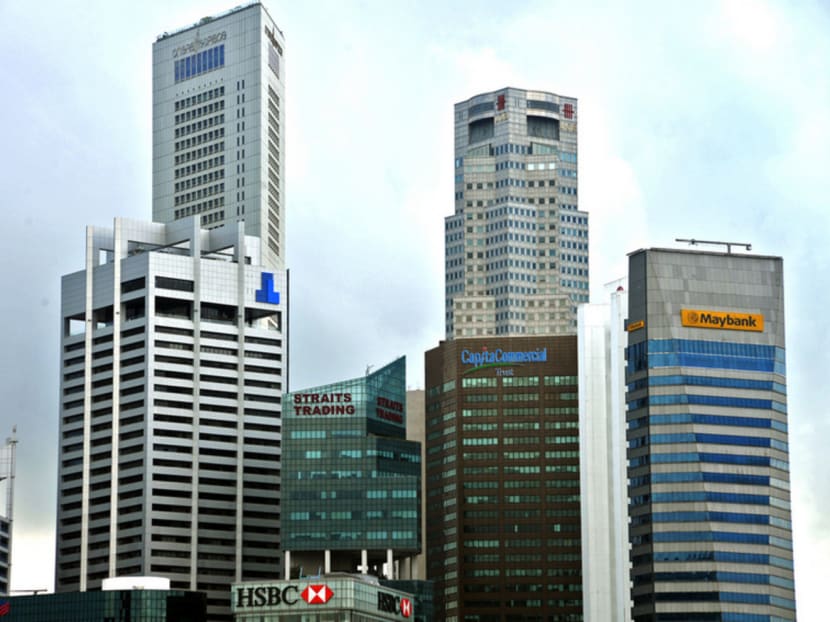S’pore still top choice for Asia-Pacific regional HQs
SINGAPORE – The Republic remains the most attractive Asia-Pacific destination for multinational companies (MNCs) to set up their regional headquarters (RHQs), but competition is expected to intensify in the coming years from cities such as Shanghai, said leading commercial real estate services firm Cushman & Wakefield.

Singapore has long been attractive to foreign investors with its tax-friendly incentives, a transparent legal framework, skilled workforce and excellent infrastructure.
TODAY file photo
SINGAPORE – The Republic remains the most attractive Asia-Pacific destination for multinational companies (MNCs) to set up their regional headquarters (RHQs), but competition is expected to intensify in the coming years from cities such as Shanghai, said leading commercial real estate services firm Cushman & Wakefield.
Economic growth in Asia Pacific over the last decade has outpaced Europe and the United States, and the region is forecast to increase its share of global gross domestic product from 31 per cent last year to 36 per cent by 2030, said the property consultancy in a report. Despite recent market volatilities, economies in the region are well-positioned to offer rich long-term opportunities and, as businesses continue to seek locations close to their target markets, the number of RHQs in Asia Pacific is expected to increase.
Dr Dominic Brown, Cushman & Wakefield’s head of Australia & New Zealand research and co-author of the report, said: “Economic growth in Asia Pacific will propel MNCs into the region. This growth is based upon the rise of the middle class in the region, growth in the technology, media and telecommunications (TMT) sector as well as economic growth in ASEAN.”
Singapore and Hong Kong, the top two RHQ locations, respectively, are well established and have long-standing favourable economic and regulatory environments designed to attract MNCs. However, Hong Kong faces a higher cost of living and increasing competition from Tier 1 Chinese cities, said Cushman & Wakefield.
Numerous global TMT companies have set up RHQs in Singapore, including Microsoft, LinkedIn and Cisco Systems, attracted by the Republic’s excellent network connectivity, noted the report. Social networking giant Twitter set up its Asia-Pacific headquarters in Singapore last year and HubSpot, an in-bound marketing and software company, also chose the Republic for its RHQ.
Like Hong Kong, Singapore has long been attractive to foreign investors with its tax-friendly incentives, a transparent legal framework, skilled workforce and excellent infrastructure. However, the report noted the Republic is the only economy in Asia, and one of only two in the Asia Pacific, along with Australia, that retains an AAA credit rating from all three ratings agencies. It is also helped by being in the same time zone as key Asian markets, such as China and Malaysia, with many of its residents bilingual in English and Mandarin or Malay.
In the past, the main challenge for Singapore as an RHQ location has been its distance from China, but this is now balanced by its status as a gateway to the growing South-east Asia region and its emerging position as a bridge between India and China, said the report.
Hong Kong both benefits and suffers from being on China’s doorstep. Its location gives ready access to the world’s manufacturing hub and a rapidly growing consumer market, but Cushman & Wakefield said there is an increasing number of MNCs who choose to locate major operational centres on both sides of the border, giving Shanghai increasing viability as an RHQ location.
Still, Hong Kong, in contrast to Shanghai, has one of the most competitive tax systems in the world, with low headline rates and ease of administration. A talented pool of qualified English-speaking professionals remains a major plus for Hong Kong and has helped make the city a major destination for international RHQs. Unfettered growth has its downside, though, and residential prices are very high, making living in Hong Kong costly, while operational costs for businesses are steep, noted the report.
Direct access into China has been the main propulsion behind the rise of Shanghai, though it has also been aided by its diverse economic base, access to local talent and the fact that it is the commercial heart of China, said the report. However, the cost of land and cost of leasing prime properties are concerns, as are rising salaries and mounting local business competition.
The top three — Singapore, Hong Kong and Shanghai — are stepping up efforts to continue to attract and accommodate RHQs, noted the report. The Singapore government is encouraging development of space outside the CBD in areas such as Jurong Gateway, Changi Business Park and Paya Lebar Central. Likewise, Hong Kong is addressing office space shortages by means such as decentralisation to Kowloon East and Kowloon West. Shanghai has no shortage of space and new industry hubs are being developed to boost the city’s development.
Meanwhile, the RHQ model is changing and adapting to economic development in the Asia-Pacific region, with many companies moving from the “one size fits all” approach to a “multi-nodal” one, noted the report.
Dr Brown said: “As the region continues to develop and advance, opportunities in emerging markets will begin to appear. For example, the rise and improving maturity of ASEAN economies is likely to offer substantial opportunities, not least because occupancy costs per workstation in Bangkok and Kuala Lumpur are less than a third of those in Singapore.”





